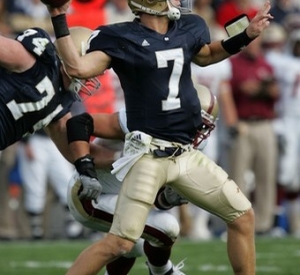Statistically Speaking: Notre Dame vs. Boston College

Boston College had their way with Notre Dame Saturday.
The visiting Irish repeatedly turned the ball over, lost the time of possession battle, and converted only 33 percent of their third downs. The red zone offense didn’t even have a chance to continue it’s ineptitude as the floundering Irish failed to cross their opponent’s twenty-yard line.
Notre Dame’s offense looked completely unprepared. Despite being a key to victory and coming off a lackluster performance in the second half against Pittsburgh, the Irish looked thoroughly stale, limping their way to the lowest total offense and point outputs of the year. Even though emotion was an off-season focus of head coach Charlie Weis, the Irish have played uninspired football on more than one occasion this season.
As noted here, Notre Dame has relied heavily on the big play all year. This dependency was never more apparent than against the Eagles where the Irish reliance on big plays spelled out in disastrous fashion.
The book is out on how to defend Weis’ seemingly vaunted offense: drop seven/eight, rush four/three, make quarterback Jimmy Clausen hold the ball, and force consistent execution to move the ball. North Carolina, Pittsburgh, and Boston College have now followed this script to alarming success.
As if it mattered, the defense turned in an excellent performance. Despite exceptional field position for Boston College and five Irish turnovers, Notre Dame’s defense held the Eagles to ten points, 251 yards, and 13 first downs. All this was undone by a nauseating offensive performance and nearly-as-bad special teams play.
Offense
Entering Saturday’s contest with Boston College Notre Dame averaged six big plays for over 166 yards per game. This works out to about 43 percent of the total offense with most of the yardage coming in the passing game.
Against the Eagles the Irish offense had a single big play for 32 yards, only 11 percent of the total offense. The Achilles heel has been exposed.
Clausen had his worst outing of the season—and arguably in an Irish uniform—completing just over 56 percent of his passes for 226 yards, no touchdowns, and four interceptions. The 4.9 yards per attempt and 8.7 yards per completion were, by far, season lows.
Of course, Clausen didn’t get much help from the running game. The Irish managed just 66 yards on 21 carries (3.1 yards per attempt) as the woeful running game continues to be a huge liability. Even more remarkable is the lack of improvement seen over the course of nine games.
If the poor rushing and passing offense wasn’t enough, the Irish converted only 33 percent of third downs, largely due to their down and distance situations. In what is becoming a recurring theme, Notre Dame spent 80 percent of their third downs with five or more yards needed to move the chains.
Minus the Washington game, the Irish offensive routine is becoming predictably incompetent since the second half against the Tar Heels.
Defense
Plain and simple, if your defense surrenders only ten points, you should win.
The defense did just that Saturday. And they did it despite five Irish turnovers, excellent field position for the Eagle offense, and a losing time of possession battle.
Boston College quarterback Chris Crane managed only 79 yards through the air, completing a paltry 41 percent of his attempts. Moreover, Crane averaged only 3.6 yards per attempt and 8.8 yards per completion. Those numbers are remarkably low and indicative of excellent play by the Irish secondary.
The Irish rush defense wasn’t as stellar but, much like the Pittsburgh game, it was good enough to win. Boston College managed 172 yards on 38 carries for 4.5 yards per attempt. However, they were largely unable to run the ball when they needed it most.
Notre Dame also only allowed ten points to come from four red zone tries and forced the Eagle offense into unmanageable third down distances all night. Boston College converted only 21.4 percent of their third downs because they required at least five yards to move the chains in every instance.
Special Teams
Punting was particularly challenging for the Irish against Boston College. Eric Maust averaged a pedestrian 31.3 yards punt, made worse only by relatively poor punt coverage. This led to an unacceptable 26.1 net yards per punt.
The punt return team put out one of its best performances of the year, averaging 14.7 yards per return. However, this average was heavily weighted by Golden Tate’s long return and largely offset by his fumbled catch.
The rest of the special teams units didn’t see much action.
Summary
Poor punting and five turnovers gave the Eagles a short field for much of the evening. Even so, the Irish defense played well enough to win.
For the third game in four outings it was the Irish offense that was mostly to blame for the loss. Lethargic offensive line play has begun to translate into poor pass protection against minimal defensive pressure and continues to be at the heart of an inexcusably destitute rushing attack.
Weis has exhausted his good grace generated from good seasons in 2005 and 2006, his alumnus status, and his excellent recruiting. It is becoming painfully obvious that the Irish have only marginally improved from the 2007 debacle, giving fans few signs of hope that Weis can bring Notre Dame back to a spot among the elite.

